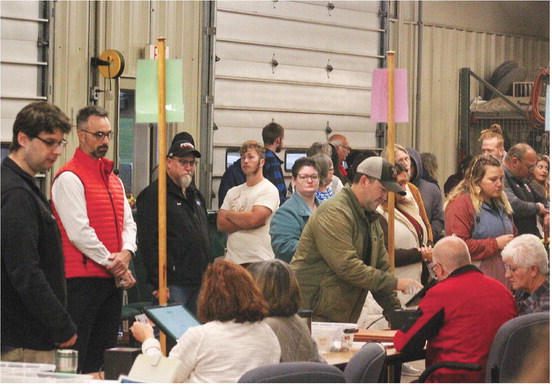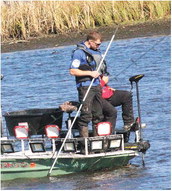Ayon killer found guilty


A 42-year-old Mosinee man has been found guilty by a Clark County jury of stalking and murdering Cassandra Ayon of Loyal and then hiding her corpse in 2020.
It took the 12-person jury about seven hours last Friday to convict Jesus Contreras- Perez of first-degree intentional homicide, hiding a corpse and stalking. The verdict came at the end of a oneweek trial in which jurors heard testimony from a wide variety of witnesses, including police, friends, family and data experts.
Contreras-Perez was arrested and charged in 2021 after Ayon, 27, went missing on Oct. 3, 2020, having last being seen at a trailer park in Unity. Her body has never been found, and neither has the car she was driving.
At one point on Friday, the jury sent a message to Judge Daniel Diehn indicating that a juror was having trouble finding Contreras-Perez guilty without a body having been found. The judge sent a message back urging the jurors to continue deliberating, and eventually, the jury reached a unanimous guilty verdict on all three counts.
No DNA or other physical evidence was ever found connecting Contreras-Perez to Ayon’s disappearance, so assistant attorney general Annie Jay and Clark County district attorney Melissa Inlow focused on the defendant’s activities before and after she went missing.
“The defendant told Cassandra exactly what he was going do to her,” Jay said. “He followed through. The defendant wiped Cassandra off the face of the Earth.”
Defense attorney Claire Longdin tried to poke holes in the prosecution’s case by questioning why other potential suspects weren’t more thoroughly investigated and reframing the relationship between Ayon and her client.
“Detectives looked at everything the defendant had – all the vehicles he drove, his cell phones,” she said. “They searched his home, and they recovered nothing to connect him to Ms. Ayon’s disappearance. They never even established that she is dead.”
The jury heard from 33 witnesses called by the prosecution, compared to just six from the defense.
The prosecution’s case relied heavily on statements from Ayon’s co-workers and friends, who said she was afraid of Contreras-Perez and felt he was following her in the weeks and hours leading up to her disappearance.
One co-worker, Ashley Nesbitt, said Ayon would say if anything ever happened to her, Contreras-Perez was the one responsible. Nesbitt said Ayon also told her that Contreras-Perez “would know how to hide her so nobody ever found her.” She said they discussed getting a restraining order against him, but Ayon did not want to upset him.
On the night before her disappearance, friends who were with her at a gathering in Marshfield testified she was convinced that Contreras-Perez was following her and kept looking out the window.
Mario Salguero, the last person to see Ayon before she disappeared, said he never actually saw anyone following them as they traveled to Marshfield and back to his place in Unity, but he said Ayon was convinced that Contreras-Perez was after her. Salguero said Ayon left his trailer between 3 and 3:30 a.m. on Oct. 3, and he never heard from her again.
When police questioned him, Salguero said he had nothing to hide and allowed investigators to search his trailer and look through his cell phone. His vehicle was never searched, however.
On the night before she disappeared, someone entered Ayon’s vehicle while it was parked at Marathon Cheese, where she worked. Prosecutors used surveillance footage and cell phone location data to show that Contreras-Perez was most likely the one who entered the vehicle, and then returned later in the night to approach her vehicle again.
A red Ford Explorer SUV driven by the defendant was used to place him at the Marathon Cheese parking lot, and it was also spotted by a resident of the trailer park in Unity around the time Ayon disappeared.
Prosecutors also spent a fair amount of time trying to prove that Contreras-Perez entered Ayon’s vehicle on Sept. 18, 2020, and stole her cell phone and a cell phone belonging to a male acquaintance. Surveillance footage at the Kwik Trip in Abbotsford where the phones were stolen does not definitively show Contreras-Perez entering Ayon’s vehicle, but data from nearby cell phone towers suggests that he was in the area at the time.
Longdin, however, questioned whether the cell phones could have been stolen by drug users known to commit thefts in the area.
Both the prosecution and the defense called expert witnesses regarding cell phone location data, which is based on communications between cell phones and towers within a certain radius.
Michelle Wright, a criminal analyst at DCI, helped develop maps showing the general locations of Ayon and Contreras- Perez’s cell phones based on their proximity to cell phone towers in the area. Wright acknowledged that tracking cell phones this way is “not an exact science,” and phones can often be miles away from the cell towers “lighting up” on the map.
On the morning of Ayon’s disappearance, defense attorney Longdin pointed out that Contreras-Perez’s cell phones were in the Mosinee area where he lived, several miles away from where Ayon went missing near Unity. Assistant DA Jay, however, got the experts to state that turning off a cell phone would cause it to stop transmitting signals, making it appear as though it stayed in the same place even though it moved around.
Attention was also paid to the defendant’s movements after the disappearance. Just a couple days after Ayon went missing, Contreras-Perez left the farm where he had been working for 18 years and never returned. He left just a few hours before police investigators arrived to question him.
Evidence shows that Contreras-Perez purchased a new cell phone with a 608 area code, and then took off for Iowa and Minnesota. He eventually returned to Wisconsin and was pulled over by a county deputy as he entered Clark County on STH 29. His vehicle was searched by officers and cadaver dogs, but no evidence was found that Ayon had been in the vehicle.
Prior to being pulled over, Contreras-Perez had contacted Clark County dispatch and said he wanted to speak to someone working on the case so he could clear his name.
“The only reason I left is because I’m scared,” he said during a phone conversation with dispatcher Sierra Wilson. “I’m just really scared.”
When speaking to Scott Klueckmann, a detective working on the case, Contreras- Perez agreed to come to the sheriff’s department. He continued to insist that he had nothing to do with Ayon’s disappearance.
“I love her so much,” he said in a phone conversation with Klueckmann. “I would never do anything to hurt her.”
At some point after he returned to the area, Contreras-Perez was involuntarily admitted to North Central Health Care Center after expressing suicidal thoughts. Kim Javorek, his employer at the farm, said phone conversations with Contreras-Perez during this time had her worried about his wellbeing.
“We were afraid he was going to take his life,” she said.
Whenever a police investigator was called to the stand, Longdin would question them about other possible suspects in the case, including a coworker who had apparently made Ayon uncomfortable at work and posted angry Facebook videos about her.
Klueckmann said police interviewed all potential suspects and ruled them out based on the available evidence.
“We went wherever our evidence pointed us to,” he said.
Det. Aaron Ruggles said police came up with “no other credible suspects,” and “no indication she was still alive.”
The defense also tried to emphasize instances when Ayon would express jealousy about Contreras-Perez’s other romantic interests. Kaite Moeller, the defendant’s current girlfriend, told Longdin that Ayon would brag about being in a relationship with Contreras-Perez and call her derogatory names. “She threatened me multiple times,” she said.
Besides cell phone data, prosecutors displayed suspicious internet searches made by Contreras-Perez in the weeks leading up to Ayon’s disappearance. These included searches for “cell phone signal jammers” and “how to make a homemade silencer,” among others. Under cross-examination by Longdin, one officer acknowledged that no silencers or guns were ever found in relation to the case.
During closing arguments, Longdin pointed out problems with the prosecution’s timeline of events on Oct. 3, 2020 – issues which would have made it nearly impossible for Contreras-Perez to kill Ayon, hide her body and her vehicle and make it into work by 7:24 a.m. that morning.
The prosecution said this is why Contreras- Perez was charged as a party to a crime, meaning that someone likely aided and abetted him in the crimes.
“It’s undeniable he had help,” ADA Jay said. “He can’t drive two vehicles at the same time. He had help.”


